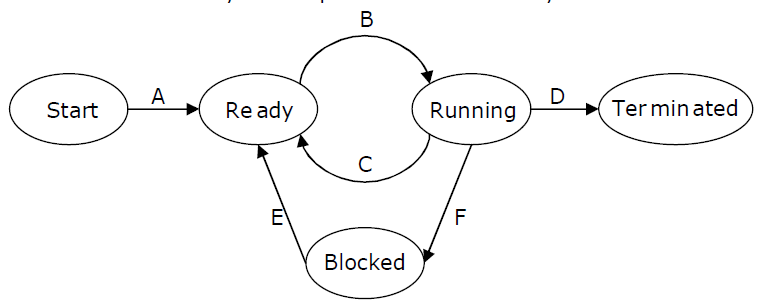OS CPU Scheduling
Question 11
I. Shortest remaining time first scheduling may cause starvation II. Preemptive scheduling may cause starvation III. Round robin is better than FCFS in terms of response time
Question 12

I. If a process makes a transition D, it would result in
another process making transition A immediately.
II. A process P2 in blocked state can make transition E
while another process P1 is in running state.
III. The OS uses preemptive scheduling.
IV. The OS uses non-preemptive scheduling.
Which of the above statements are TRUE?
Question 13
Group 1 contains some CPU scheduling algorithms and Group 2 contains some applications. Match entries in Group 1 to entries in Group 2.
Group I Group II (P) Gang Scheduling (1) Guaranteed Scheduling (Q) Rate Monotonic Scheduling (2) Real-time Scheduling (R) Fair Share Scheduling (3) Thread Scheduling
Question 14
Process Execution time Arrival time P1 20 0 P2 25 15 P3 10 30 P4 15 45What is the total waiting time for process P2?
Question 15
Question 16
Three processes A, B and C each execute a loop of 100 iterations. In each iteration of the loop, a process performs a single computation that requires tc CPU milliseconds and then initiates a single I/O operation that lasts for tio milliseconds. It is assumed that the computer where the processes execute has sufficient number of I/O devices and the OS of the computer assigns different I/O devices to each process. Also, the scheduling overhead of the OS is negligible. The processes have the following characteristics:
Process id tc tio
A 100 ms 500 ms
B 350 ms 500 ms
C 200 ms 500 ms
The processes A, B, and C are started at times 0, 5 and 10 milliseconds respectively, in a pure time sharing system (round robin scheduling) that uses a time slice of 50 milliseconds. The time in milliseconds at which process C would complete its first I/O operation is ___________.
Question 17
Process Arrival Time Burst Time P1 0 12 P2 2 4 P3 3 6 P4 8 5The average waiting time (in milliseconds) of the processes is _________.
Question 18
Process Arrival Time Burst Time
P1 0 5
P2 1 3
P3 2 3
P4 4 1
What is the average turnaround time for these processes with the preemptive shortest remaining processing time first (SRPT) algorithm ?
Question 19
There are 56 questions to complete.